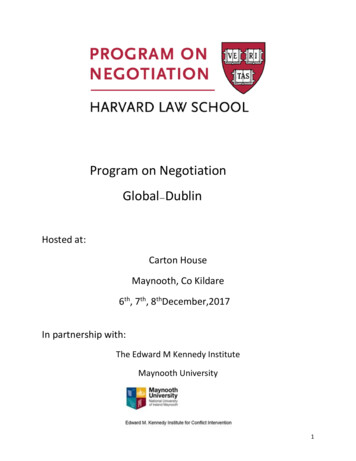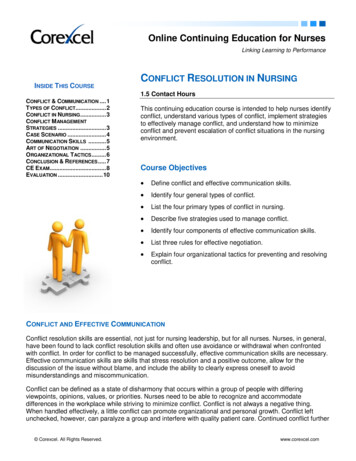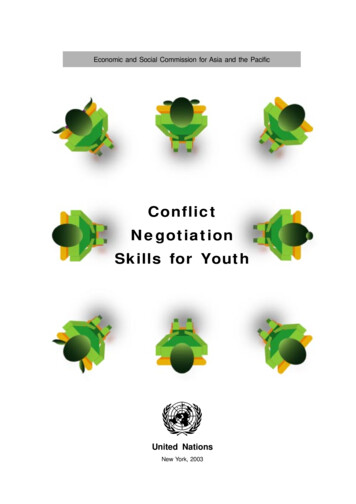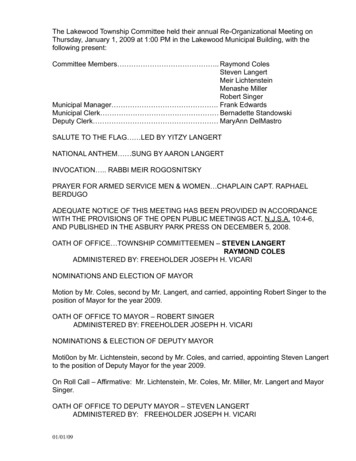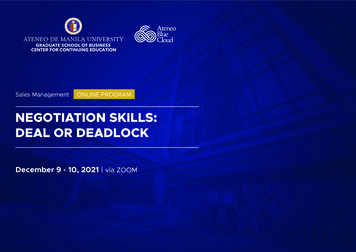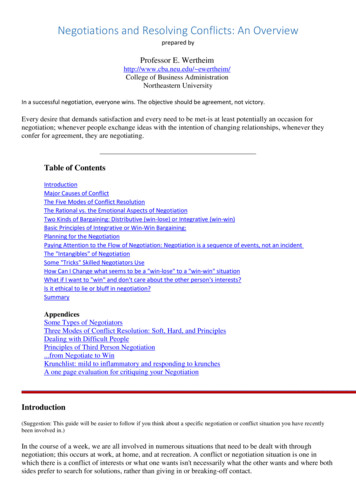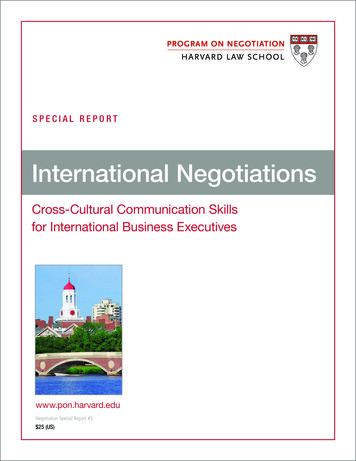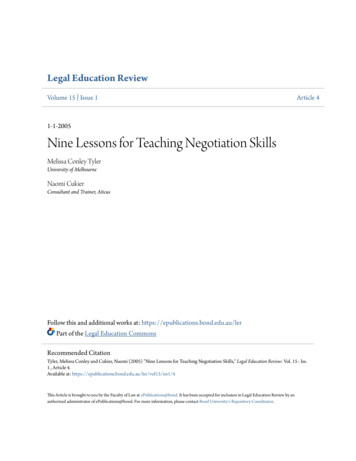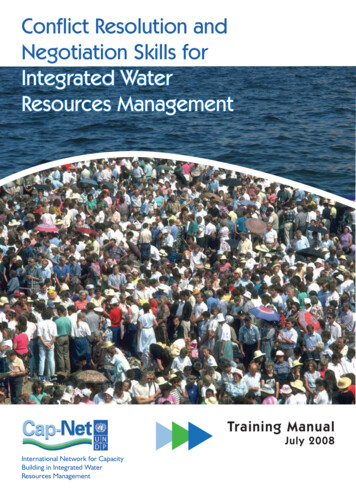
Transcription
Conflict Resolution andNegotiation Skills forIntegrated WaterResources ManagementTraining ManualJuly 2008International Network for CapacityBuilding in Integrated WaterResources Management
AcknowledgementsThis training manual has been developed by Larry A. Swatuk, Alemayehu Mengisteand Kidanemariam Jembere who have been active in presenting training courses invarious parts of Africa and Asia. The content is has greatly benefited from existing materials and the experience of using the materials in training courses held by Cap-NetBangladesh, Nile IWRM-Net, WA-Net ArgCapNet, REDICA and LA-WETnet. SimoneNoemdoe provided editorial support.Main material sources used and adapted include:XConflict Prevention and Cooperation in International Water Resources by WaterNet, UNESCO and UNESCO-IHE, (http://www.unesco.org/water/wwap/pccp/sadc.shtml )XNegotiation and mediation techniques for natural resource management manualdeveloped by the Food and Agricultural Organisation (FAO), )Cap-Net would like to acknowledge the various contributions mentioned above as wellas the feedback from participants from the various training courses held. Any omissionor error is the responsibility of Cap-Net.These materials are freely available for use, adaptation and translation as desired andcan be downloaded from the Cap-Net web site (www.cap-net.org) or requested on CDtogether with all of the resource materials and Power Point presentations. Please giveappropriate acknowledgement to the source when using the materials.(i)Conflict Resolution and Negotiation Skills for Integrated Water Resources Management
Overview - Why this Manual?Conflict is the gadfly of thought. It stirs us to observation and memory. Itinstigates to invention. It shocks us out of sheep-like passivity, and setsus at noting and contriving Conflict is the sine qua non of reflectionand ingenuity.- John Dewey (1922; quoted in NOSR, 2007)Regardless of its origins, the omnipresence of (latent) conflict requirespeople to manage conflict and to reach agreement. In a way, it can evenbe argued that most, if not all institutions are systems to manage political, governmental, or judicial opposition and contradiction, that is, aresystems to manage conflict.- Netherlands Organisation for Social Research (NOSR, 2007)Conflict is an unavoidable aspect of human social systems. Indeed, and as framed byDewey in the epigram above, many argue that conflict is a necessary fact of life, for itis only through struggle that lasting and meaningful change can be brought about. TheNOSR (2007) defines conflict in the following way:Conflict is a process that begins when an individual or group perceives differences and opposition between oneself and another individual or groupabout interests and resources, beliefs, values or practices that matter tothem. This process view can be applied to all kinds of parties – nations,organizations, groups, or individuals – and to all kinds of conflict – fromlatent tensions to manifest violence.Given the central importance of water resources to all human communities, it is naturalthat conflicts arise with regard to access, allocation, development and managementof the resource. It is equally clear, however, that necessity is not only the motherof invention, but also the basis for extensive cooperative activities concerning themanagement of water resources. Thus both conflictual and cooperative behaviours –across time and space and at all levels of human social organization – constitute thenorm where water resources are concerned.It is generally acknowledged that water resources of all types are under increasing pressures from a number of actors, forces and factors manifest in the early 21stCentury world (WWDR, 2006). Of particular concern is the way in which sovereignstates will deal with increasing (seasonal, absolute, natural, human-made) scarcitiesin shared river basins. Geography is thought to play a special role, with location inthe basin (upstream/downstream) and in the environment (arid/semi-arid ecosystems)regarded as key factors in future water conflict. Global warming is also thought to poseparticular challenges to water-stressed societies and communities that must developmitigation and adaptation mechanisms in order to survive. At the national level, important questions have arisen concerning the optimal use of limited resources. Debatesand disputes are now popping up between and among a wide variety of users (e.g.,urban/rural; industry/agriculture; humans/the environment, rich/poor people) withinand across watersheds, ecosystems, basins, political jurisdictions and increasinglycrowded cities.Given the diversity of needs and interests that surround water, disputes and conflictsover the resource are normal. That is to say, they are to be expected. Not all disputesConflict Resolution and Negotiation Skills for Integrated Water Resources Management(ii)
lead to conflict, however; and not all conflicts turn violent. Some fester perpetually beneath the surface and, as with limited access to potable water in many parts of urbanareas, are part of settled social relations. However, a change in the setting – such asan unexpected drought or flood, or a change in government policy – can bring longsuppressed grievances to the surface.What is to be done about such events and eventualities? Should we not be prepared?The intention of this manual is to provide the necessary general information and specific tools in a user-friendly way so that any water resource stakeholder may be ableto resolve existing or head-off impending disputes in a way agreeable to all parties.The emphasis in this manual is on Alternative Dispute Resolution (ADR), in particular,principled negotiation – an approach that seeks to embed outcomes and processesthat will serve sustainable, equitable and efficient long-term social needs.ADR locates itself within the larger framework of , integrated water resources management (IWRM) now regarded as an important framework for sustainable resourceuse and management. Within the IWRM framework, Cap-Net, among other institutions, groups and networks, has facilitated a number of Conflict Resolution and Negotiation workshops for water managers in anticipation of impending and/or intensifyingstruggles over the resource. Each of us has been involved – working separately,together, and as part of a larger team – in the planning and implementation of severalof these workshops at national (e.g. Ethiopia Country Water Partnership), regional(e.g., SADC, Nile-IWRMnet and global (combining regions and countries) levels. Wehave distilled our experiences down into this training manual that will act as a handyresource in the field of conflict resolution and negotiation for IWRM.References1. NOSR (Netherlands Organisation for Scientific Research), 2007. Conflict andSecurity - Final Version. NOSR: The Hague2. United Nations, 2006. Water: A shared responsibility, World Water DevelopmentReport 2. New York and Geneva: UNESCO and Berghan Books.(iii)Conflict Resolution and Negotiation Skills for Integrated Water Resources Management
ContentsINTRODUCTION1. World Water Crisis2. A Crisis Of Governance3. Transboundary Water Governance4. Integrated Water Resources ManagementReferences112333MODULE 1: INTEGRATED WATER RESOURCES MANAGEMENT (IWRM) ANDCONFLICT RESOLUTION1.1 What Is Integrated Water Resources Management (IWRM)?1.2 Principles And Key Criteria Underpinning IWRM1.3 Tipping Points For Conflict And Cooperation1.4 IWRM and Conflict ManagementReferences55891316MODULE 2: APPROACHES TO CONFLICT MANAGEMENT2.1 Managing Conflict2.2 Methods Of Conflict Resolution2.3 Requirements For Successful Conflict Resolution2.4 Staying On Track: The Conflict Process Map2.5 Analyzing ConflictReferences17171922242539MODULE 3: NEGOTIATING FOR CONFLICT RESOLUTION3.1. Negotiation3.2 Approach and Methods of Negotiation3.3 The Mediator Approaching The DisputeReferences4141454759MODULE 4: WATER AGREEMENTS AND MANAGEMENT ARRANGEMENTS4.1 Introduction4.2 International Rivers4.3 National/Local Level AgreementsReferences6161616777MODULE 5: IMPLICATIONS FOR INTEGRATED WATER RESOURCESMANAGEMENT5.1 Introduction5.2 Key IssuesReferences79797982Annexure 1: Sample Cource ProgrammeAnnexure 2: Tips For TrainersAcronyms839094Conflict Resolution and Negotiation Skills for Integrated Water Resources Management(iv)
Introduction1. World Water CrisisWater is central to human development. The ability to harness water resourcesfor human use has enabled the rise of complex civilizations. Globally, aggregate national water use varies directly with both Gross National Income (GNI)and Human Development Index (HDI) values. Water is both a common andprecious commodity. It exists in abundance but is not always located where orwhen we humans need it. Of course, we have not helped matters. For most ofhuman history, we have had limited impact on the resources around us. Withrapid technological and social change throughout the last 500 years, however,our environmental footprint has grown such that we face the greatest challengeyet to human civilisation in the form of global warming. Where water resourcesare concerned,From a situation of limited,low-impact and largelyriparian uses of water, we havenow reached a point where, inmany parts of the world, cumulative uses of river resources havenot just local but basin-wide andregional impacts. The result isthat water resources in many riverbasins are fully or almost fullycommitted to a variety of purposes, both in-stream and remote;water quality is degraded; riverdependent ecosystems are threatened; and still-expanding demandis leading to intense competitionand, at time, to strife. (Svendsen,Wester and Molle, 2004: 1)Box 1.1: Water Crisis - FactsOnly 0.4% of total of global water in the world isavailable for humans.Today more than 2 billion people are affectedby water shortages in over 40 countries.263 river basins are shared by two or more nations.2 million tonnes per day of human waste aredeposited in water courses.Half the population of the developing worldare exposed to polluted sources of water thatincrease disease incidence.90% of natural disasters in the 1990s werewater related.The increase in numbers of people from 6 billion to 9 billion will be the main driver of waterresources management for the next 50 years.Source: WWDR 2, 2006Thus, today it is generally agreed that we face a world water crisis.Access to water is fundamental to human survival, health and productivity. Butthere are many challenges related to ensuring the perpetual sustainability ofpeople’s access to water for various purposes. Many development projectshave not viewed water within the environment as being an exhaustible supply and the approach was mostly sectoral and non-integrated, causing manypressures on the limited resource. The results of this approach, together withexternal factors (most notably population increase and climate change) haveproduced situations where the water source has either run out or is severelyConflict Resolution and Negotiation Skills for Integrated Water Resources Management1
stressed. Moreover it is resulting in many disasters such as pollution, overexploitation of aquifers, drying-up of springs, floods, and funds wasted on manyinappropriate projects.2. A Crisis of GovernanceWhile an understanding of water resources, their dynamics and limitationson abstraction is considered to be essential to permitting the developmentof sustainable water management strategies, it is generally recognized thatthe problems of today and tomorrow are as much a consequence of poorgovernance as they are of absolute scarcity (see, UN WWDR2, Chapter 2 fordetails).Governance is both outcome and process, involving a variety of legitimate andauthoritative actors. As an outcome it reflects settled social relations. If it isgood, it suggests widespread – if not universal – social approval of its practices. Good governance can never reach an end point; as a process it dependson the reiteration of activities that deepen trust.Box 2: Water Governance‘Water governance refers to the range of political, social, economic and administrative systems that are in place to develop and manage water resources, and thedelivery of water services at different levels’ (Rogers and Hall, 2003).According to the authors of the UN World Water Development Report 2 watergovernance has four dimensions:A social dimension concerned with ‘equitable use’;An economic dimension concerned with ‘efficient use’;An environmental dimension concerned with ‘sustainable use’; andA political dimension concerned with ‘equal democratic opportunities’.Each of these dimensions is ‘anchored in governance systems across three levels:government, civil society and the private sector’. To realize ‘effective governance’,the UN Report proposes a checklist that includes the iveness And Efficiency;Rule Of ation; andEthical Considerations.The absence of some or all of these practices has resulted in ‘bad’ or ‘poor’ governance, a simple definition of which is the inability and/or unwillingness to alterpatterns of resource allocation, use and management despite clear evidence of resource degradation, uneconomic behaviour and abiding poverty and social inequality(UN, 2006: 49)Source: World Water Development Report 2, 20062Conflict Resolution and Negotiation Skills for Integrated Water Resources Management
3. Transboundary Water GovernanceComplicating the issue further is the fact that most of the planet’s people livewithin one of the estimated more than 300 river basins shared by two or morestates (Milich and Varady, 1999). These basins cover more than 45% of theearth’s surface, and ‘of the 145 states occupying international river basins,almost two-thirds (92) have at least half of their national territory lying in aninternational basin, and more than one-third (50) have 80 percent or more ofnational territory in an international basin’ (Conca, 2006). Given that sovereignstates arrogate to themselves the right to develop resources located withintheir territory, and given that water is fugitive – so not respecting internationalpolitical boundaries – as demands for water increase across communities,states and sectors, the likelihood of conflicts over water increases.4. Integrated Water Resources ManagementAvoiding or minimizing the negative affects of physical and human-induced resource scarcity ‘will require institutional innovations that allow focusing simultaneously on the goals and tradeoffs in food security, poverty reduction, andenvironmental sustainability’ (Molden, 2007: 62). Such a perspective has nowcrystallized in the concept Integrated Water Resources Management (IWRM),within which conflict resolution is regarded as an important tool.References1. Conca, K., 2006, Governing Water: Contentious Transnational Politics andGlobal Institution Building. Cambridge, Mass: MIT Press.2. Milich, L. and R.G. Varady, 1999. ‘Openness, Sustainability and PublicParticipation: new designs for transboundary river basin institutions’, Journal of Environment and Development, 8:3, 258-306.3. Molden, D., et al, 2004, ‘Phases of River Basin Development: the Needfor Adaptive Institutions’, in M. Svendsen, ed., Irrigation and River BasinManagement: options for governance and institutions, (Cambridge, Mass:CABI).4. Rogers, P. and A.W. Hall, 2003. Effective Water Governance. TECBackground Papers 7. Stockholm: Global Water Partnership.5. Svendsen, M., P. Wester and F. Molle, 2004, ‘Managing River Basins: anInstitutional Perspective’, in M. Svendsen, ed., Irrigation and River BasinManagement: options for governance and institutions, (Cambridge, Mass:CABI)6. United Nations, 2006, Water: A Shared Responsibility. World WaterDevelopment Report 2. New York and Geneva: UNESCO and BerghahnBooks.Conflict Resolution and Negotiation Skills for Integrated Water Resources Management3
1Module 1: Introduction to IntegratedWater Resources Management(IWRM) and Conflict ResolutionLearning objectivesTo describe the meaning and main principles of IWRM and demonstrate itsrelevance for managing conflicts.To describe the various tipping points for conflict and cooperation on waterresources.OutcomesThe participant will have a clear understanding of:The link between IWRM, conflict and conflict management; andThe relevance of conflict management skills.SkillsThe participant will be able to:Identify possible entry points to systematically analyse his or her own particularsetting through the lens of IWRM; andPerceive conflict resolution from the perspective of Alternative Dispute Resolution(ADR).1.1 What is Integrated Water Resources Management(IWRM)?The basis for integrated water resources management is simply the fact that manydifferent uses of water resources are interdependent. That is evident to us all. Highirrigation demands and polluted drainage flows from agriculture mean less freshwaterfor drinking or industrial use; contaminated municipal and industrial wastewater pollutes rivers and threatens ecosystems; if water has to be left in a river to protect fisheries and ecosystems, less can be diverted to grow crops.“IWRM is a process which promotesthe coordinated development andmanagement of water, land and relatedresources, in order to maximize theresultant economic and social welfarein an equitable manner without compromising the sustainability of vital ecosystems.” (GWP, 2000)Box 1.1: IntegratedIntegrated management means that all thedifferent uses of water resources are consideredtogether. It contrasts with the sectoral approach.When responsibility for drinking water, water forirrigation, for industry and for the environment restwith different agencies, the lack of cross-sectorallinkages leads to uncoordinated water resourcedevelopment and management, resulting inconflict, waste and unsustainable systems.Cap-Net (2005) explains IWRM as asystematic process for the sustainabledevelopment, allocation and monitoringof water use in the context of social, economic and environmental objectives.Conflict Resolution and Negotiation Skills for Integrated Water Resources Management5
1That means all the different uses of water resources are to be considered together,taking into account the wide range of people’s water needs. Water allocations andmanagement decisions should consider the effects of each use on the others, andtake account of overall social, economic and environmental goals.Box 1.2: Meaning of ManagementManagement is used in its broadest sense. It emphasises that we must not only focus ondevelopment of water resources but that we must consciously manage water development in away that ensures long term sustainable use for future generations.That means IWRM recognises the following aspects:Linkages of landscape to hydrologic cycle:The hydrological cycle is continuously affected by the modification of the landscapedue to land and water use activities. Understanding the linkages between the landscape and the hydrological cycle is important for improved water management.Consideration of the hydrological cycle throughout the year is important since waterstored in wetlands and aquifers (groundwater reservoir) through recharge during thewet season is the source of base flow in the river during the dry season. Modification of land cover through land use change (e.g., rural to urban, agriculture to urban,forest to agriculture, etc.), encroachment of floodplains and wetlands, and deforestation bring changes in the physical properties of the land surface. These land useactivities modify the landscape that brings changes in the infiltration and groundwaterrecharge processes and surface runoff and sediment transport processes that causeincreased flood flow and decreased dry season flow in the river and alteration of theriver regime.Water resources system functions:The water resources system performs a wide variety of functions that deliver goodsand services for the society and sustenance of ecosystems. Some of the functionsare:Environmental functions: recharging wetlands and groundwater, augmentationof dry season flow, assimilation of wastes, etc.;Ecological functions: providing soil moisture for vegetation, providing habitat forfish, aquatic plants and wildlife, supporting biodiversity, etc.;Socio-economic functions: supply of water for domestic use, agriculture, industryand power generation, providing conditions for navigation, recreation & tourism,etc.IWRM takes into account not only the financial and economic costs and benefits ofwater management decisions, but also the social and environmental costs and benefits. Ignoring these functions in water management decisions can have large impactson economies, the environment and livelihoods.Interdependence of land, water and ecosystems:Many land uses are dependent on water availability and influenced by water relatedhazards while land uses bring modification in the water regime. Availability and quality6Conflict Resolution and Negotiation Skills for Integrated Water Resources Management
1of water and aquatic ecosystem are affected by withdrawal of water from rivers, lakesand aquifers for a multitude of different purposes such as domestic, agriculture, industrial etc.Multiple water users, conflicting needs and increasing demand:With the growth of population and economic development, demand for water alsogrows creating stress on the finite resource - water. If adequate measures to improvewater use efficiency and to conserve this scarce resource are not taken, attaining watersecurity would be difficult. The competing water needs causes conflicts e.g., betweendomestic and agricultural uses, agriculture and industry, agriculture and fisheries, upstream and downstream, highland and lowland, rural and urban areas, etc. A majorenvironmental concern is the conflict between the water uses by humans and the waterneeded by the river itself to transport sediment, to maintain its morphology, to satisfyecological requirements. IWRM considers the full range of sectoral interests as well aswater resources allocation decisions taking into account the relevant constraints andobjectives of society.Generally IWRM promotes:A shift from a sectoral to a more cross-sectoral approach to integrate ecological,economic and social goals to achieve multiple and cross-cutting benefits;The coordinated management of water, land and related resources;Integration of the technical, social and political aspects, including conflict resolutions in demand, use and perception be it in the economic, environmental or geopolitical sense;Integration across sectors, integration of use, integration of demand, integrationwith the environment as well as integration with the people;Stakeholder participation to encourage wider ownership and to empower stakeholders. Active involvement of all affected and interested groups in resolvingconflict and promoting general sustainability to bring more resource efficient andsocially responsible water management that benefits all sections of society willinvolve new institutional arrangements; andA systems approach that recognises the individual components as well as thelinkages between them, and that a disturbance at one point in the system will betranslated to other parts of the system.In summary, water resource management need to look at the hydrological cycle in thebasin, the interaction of surface water and groundwater and the interaction of waterwith other natural and socio-economic systems. It should take into account multiplewater users, multiple purposes and conflicting needs, consider interdependence ofland, water and ecosystems, and address the role of water within the context of socialand economic development and environmental sustainability.Conflict Resolution and Negotiation Skills for Integrated Water Resources Management7
11.2 IWRM Principles and Key CriteriaAn IWRM approach is underpinned by the Dublin Principles on Water and theEnvironment. These familiar and virtually universally recognised principles are:1.Freshwater is a finite and vulnerable resource, essential to sustain life,development and the environment.Only 3% of the global water is fresh water while 97% is sea water (salty). Ofthe 3% freshwater 87% is not accessible as it is ice/glacier mostly in the PolarRegions. That means the accessible freshwater resources for use is only 0.4% ofthe global totality.2.Water development and management should be based on a participatoryapproach, involving users, planners and policy makers at all levels.Water is a subject in which everyone is a stakeholder. Real participation only takesplace when stakeholders are part of the decision-making process. The type of participation will depend upon the spatial scale relevant to particular water management and investment decisions. It will be affected too by the nature of the politicalenvironment in which such decisions take place. A participatory approach is thebest means for achieving long-lasting consensus and common agreement.3.Women play a central role in the provision, management and safeguardingof water.The pivotal role of women as providers and users of water and guardians of theliving environment has seldom been reflected in institutional arrangements for thedevelopment and management of water resources. Acceptance and implementation of this principle requires positive policies to address women’s specific needsand to equip and empower women to participate at all levels in water resourcesprogrammes, including decision-making and implementation, in ways defined bythem.4.Water has an economic value in all its competing uses and should berecognised as an economic good.Water must be managed in a way that reflects the economic value for all its usesby moving towards pricing water services to reflect the cost of its provision. Withinthis principle, it is vital to recognise first the basic right of all human beings to haveaccess to clean water and sanitation at an affordable price. Managing water asan economic good is an important way of achieving social objectives such as efficient and equitable use, and of encouraging conservation and protection of waterresources.Box 1.3: Value and charges are two different things and we have todistinguish clearly between them. The value of water in alternative uses isimportant for the rational allocation of water as a scarce resource, whetherby regulatory or economic means. Charging (or not charging) for water isapplying an economic instrument to support disadvantaged groups,affect behaviour towards conservation and efficient water usage, provideincentives for demand management, ensure cost recovery and signalconsumers’ willingness to pay for additional investments in water services.8Conflict Resolution and Negotiation Skills for Integrated Water Resources Management
1There is also a need to recognize the fundamental importance of pursuing water useand management reforms in line with the criteria that take into account social, economic and environmental conditions (GWP, 2000). These constitute the so-called ‘Triple Ebottom-line’:1. Efficiency in water use: Because of the increasing scarcity of water and financialresources, the finite and vulnerable nature of water as a resource, and the increasing demands upon it, water must be used with maximum possible efficiency.2. Equity: The basic right for all people to have access to water of adequate quantityand quality for the sustenance of human well-being must be universally recognised.3. Environmental and ecological sustainability: The present use of the resourceshould be managed in a way that does not undermine the life-support systemthereby compromising use by future generations of the same resource.Figure 1: The three pillars of Water Resources yInstitutionalFrameworkCentral- LocalRiver BasinPublic - PrivateBalance “water for livelihood” and “water as a resource”1.3 Tipping Points for Conflict and CooperationGiven what has been said about the state of the world’s water in the Introduction above,initiating change towards a ‘Triple E’ practice, although necessary, will in no doubt touchpolitical, economic and social nerves. While particular practices may be leading to environmental degradation or award resources to only certain groups in a society, thebeneficiaries of these policies and practices will be resistant to change. It is imperative,therefore, that we understand that IWRM in counselling change can create a climate forboth conflict and cooperation. Several of the key tipping points are highlighted below.Achieving Good Water GovernanceIn 2004 the Global Water Partnership (GWP) identified 13 (thirteen) key changeareas within the overall water governance framework, grouping them in terms ofan enabling environment (policies, legislative framework, financing and incentive structures), institutional roles (organizational framework, institutional capacitybuilding), and management instruments (water resources assessment, planningfor IWRM, demand management, social change instruments, conflict resolution,regulatory instruments, economic instruments, information management and exConflict Resolution and Negotiation Skills for Integrated Water Resources Management9
1change). Every one of these areas holds the potential to contribute to more equitable, efficient and sustainable water use and management. Since each onerequires current practice to change, it also holds the potential to create conflictwithin and across user groups and societies. While change is key, how one entersthis environment – the time, place and pace – are equally important.Securing Water for PeopleAccess to safe and sufficient water and sa
Conflict Resolution and Negotiation Skills for Integrated Water Resources Management (ii) Overview - Why this Manual? Confl ict is the gadfl y of thought. It stirs us to observation and memory. It instigates to invention. It shocks us out of sheep-like passivity, and sets us at noting
